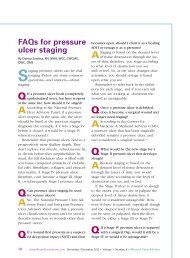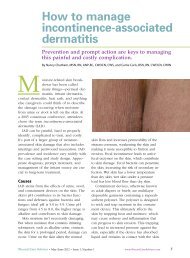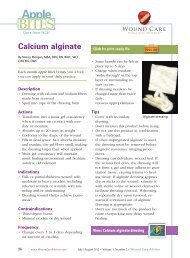ALC Cover Jan/Feb - Wound Care Advisor
ALC Cover Jan/Feb - Wound Care Advisor
ALC Cover Jan/Feb - Wound Care Advisor
Create successful ePaper yourself
Turn your PDF publications into a flip-book with our unique Google optimized e-Paper software.
stoma has a foul odor. Associated complications<br />
may include stoma retraction,<br />
mucocutaneous separation, stoma stenosis,<br />
and peritonitis.<br />
Report signs and symptoms to the primary<br />
care provider immediately. Superficial<br />
necrosis may resolve with necrotic<br />
tissue simply sloughing away. But if tissue<br />
below the fascial level is involved,<br />
surgery is necessary. A transparent twopiece<br />
pouching system is recommended<br />
for frequent stoma assessment. The<br />
pouch may need to be resized often.<br />
Stoma prolapse<br />
A stoma prolapse occurs when the stoma<br />
moves or becomes displaced from its<br />
proper position. The proximal segment of<br />
the bowel intussuscepts and slides through<br />
the orifice of the stoma, appearing to telescope.<br />
This occurs more often in loop<br />
transverse colostomies. A prolapsed stoma<br />
increases in both length and size. Prolapse<br />
may be associated with stoma retraction<br />
and parastomal hernias.<br />
Causes of stoma prolapse include<br />
large abdominal-wall openings, inadequate<br />
bowel fixation to the abdominal<br />
wall during surgery, increased abdominal<br />
pressure, lack of fascial support, obesity,<br />
pregnancy, and poor muscle tone.<br />
Unless the patient complains of pain,<br />
has a circulatory problem, or has signs<br />
or symptoms of bowel obstruction, conservative<br />
treatment is used for uncomplicated<br />
stoma prolapse. The prolapse usually<br />
can be reduced with the patient in a<br />
supine position. After reduction, applying<br />
a hernia support binder often helps.<br />
Also, a stoma shield can be used to protect<br />
the stoma. A prolapsed stoma may<br />
require a larger pouch to accommodate<br />
the larger stoma. Some clinicians use<br />
cold compresses and sprinkle table sugar<br />
on the stoma; the sugar provides osmotic<br />
therapy or causes a fluid shift<br />
across the stoma mucosa and reduces<br />
edema.<br />
Unless the patient<br />
complains of pain, has<br />
a circulatory problem,<br />
or has signs or symptoms<br />
of bowel obstruction,<br />
conservative treatment<br />
is used for uncomplicated<br />
stoma<br />
prolapse.<br />
Stoma retraction<br />
The best-formed stoma protrudes about<br />
2.5 cm, with the lumen located at the<br />
top center or apex of the stoma to guide<br />
the effluent flow directly into the pouch.<br />
In stoma retraction, the stoma has receded<br />
about 0.5 cm below the skin surface.<br />
Retraction may be circumferential or<br />
may occur in only one section of the<br />
stoma.<br />
The usual causes of stoma retraction<br />
are tension of the intestine or obesity.<br />
Stoma retraction during the immediate<br />
postoperative period relates to poor<br />
blood flow, obesity, poor nutritional status,<br />
stenosis, early removal of a supporting<br />
device with loop stomas, stoma<br />
placement in a deep skinfold, or thick<br />
abdominal walls. Late complications usually<br />
result from weight gain or adhesions.<br />
Stoma retraction is most common in patients<br />
with ileostomies.<br />
A retracted stoma has a concave, bowl-<br />
<strong>Wound</strong> <strong>Care</strong> <strong>Advisor</strong> • July/August 2013 • Volume 2, Number 4 www.<strong>Wound</strong><strong>Care</strong><strong>Advisor</strong>.com 23









